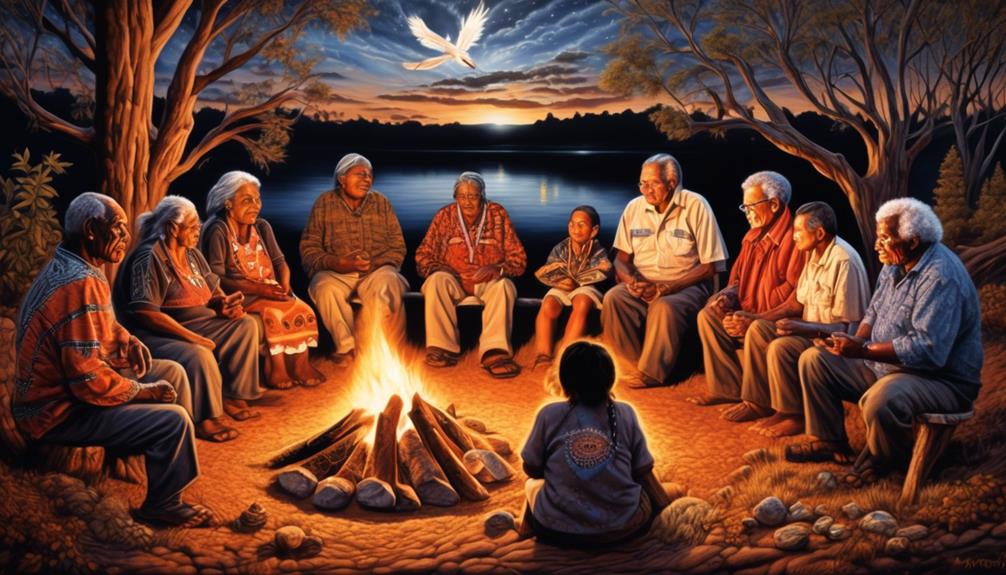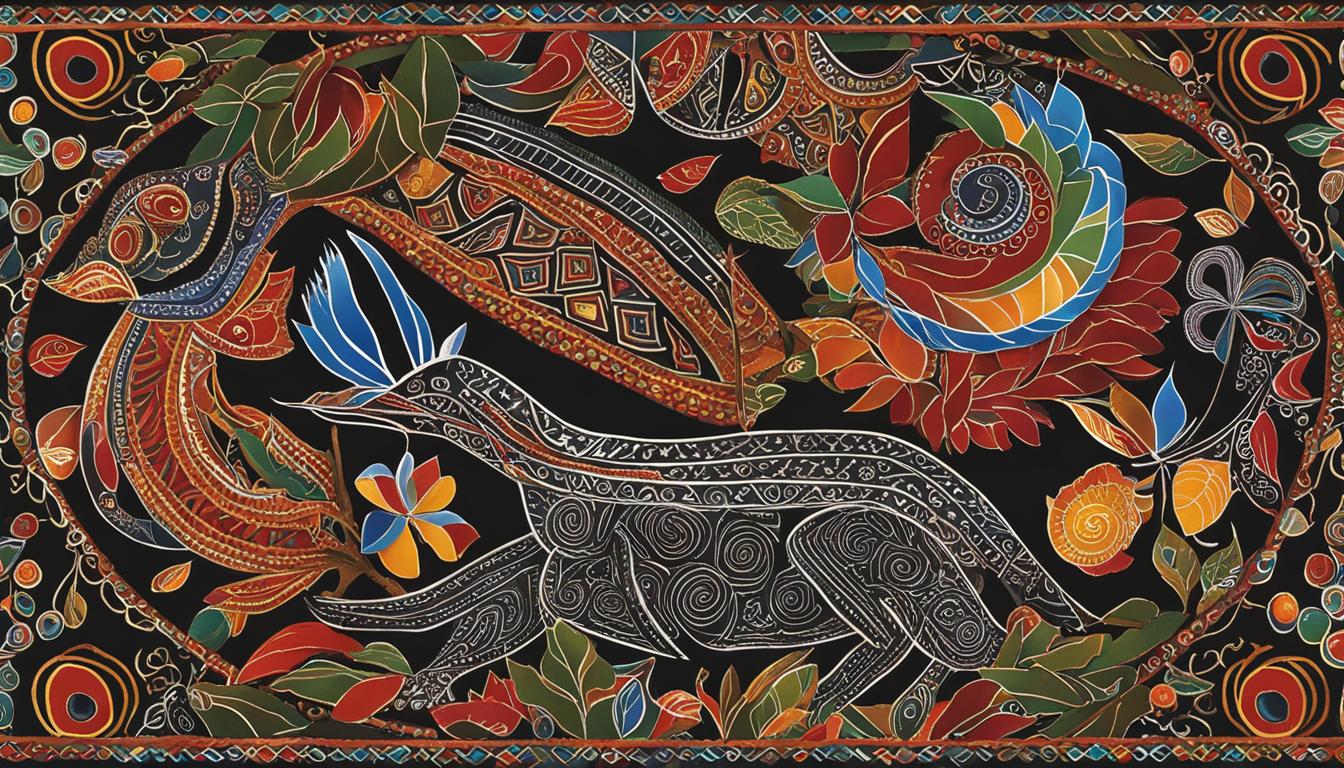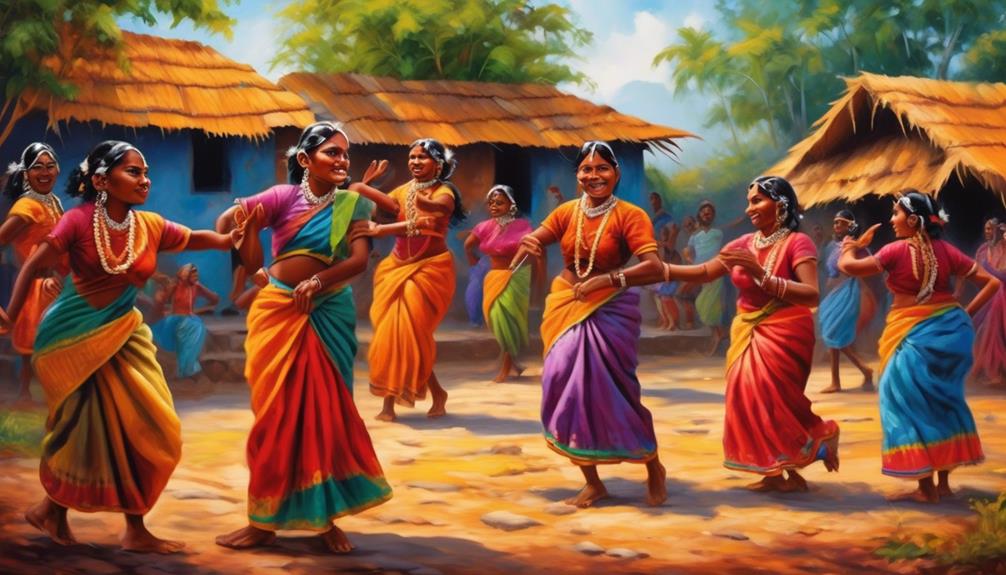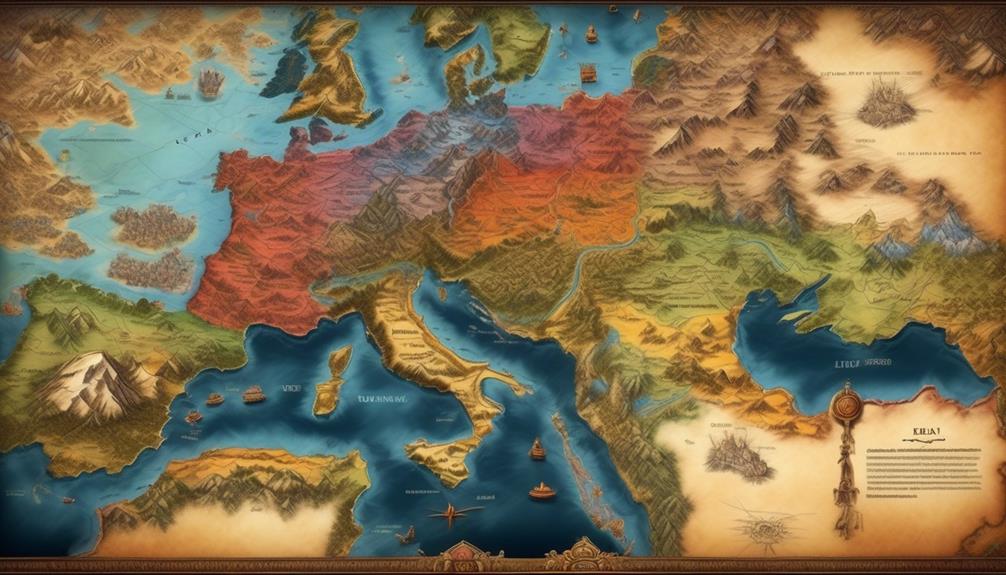The Aboriginal peoples are known for their rich and diverse history and culture, spanning thousands of years with a variety of traditions and languages.
But have you ever stopped to consider the depth of their connection to the land and the impact of colonization on their societies?
There's so much more to uncover about the Aboriginal people, their resilience, and the challenges they continue to face today.
Key Takeaways
- Aboriginal people have one of the oldest continuous cultures in the world, dating back around 65,000 years.
- The Dreaming is a complex network of knowledge, faith, and practices that explain the creation of the world and the spiritual significance of the land.
- Traditional beliefs and spiritual practices, such as song, dance, and art, play a vital role in Aboriginal societies and connect with the spiritual realm and honor ancestors.
- Aboriginal people have a deep and enduring connection to the land, viewing it as a sacred inheritance to be respected and preserved, and it holds profound significance in their culture and spirituality.
Origins of Aboriginal People
The origins of Aboriginal people can be traced back thousands of years through archaeological evidence, oral histories, and cultural traditions. Aboriginal people are believed to have migrated to the Australian continent around 65,000 years ago, making them one of the oldest continuous cultures in the world. The migration patterns of Aboriginal people are deeply intertwined with their spiritual beliefs and cultural practices.
Their connection to the land is central to their identity, and their spiritual beliefs are closely linked to the natural environment. The Dreaming, for instance, is a complex network of knowledge, faith, and practices that explain the creation of the world and the spiritual significance of the land.
Cultural practices among Aboriginal people vary across different regions, reflecting the diverse environments in which they live. These practices encompass a wide range of traditions including art, music, dance, storytelling, and ceremonies. Each of these cultural practices is deeply rooted in their spiritual beliefs and serves as a way to connect with their ancestors and the natural world.
The spiritual beliefs of Aboriginal people are centered on the concept of the Dreaming, which encompasses their understanding of the world, its creation, and their place within it. This spiritual framework guides their interactions with the land, animals, and other people, and reinforces the importance of preserving their cultural heritage for future generations.
Indigenous Cultural Traditions
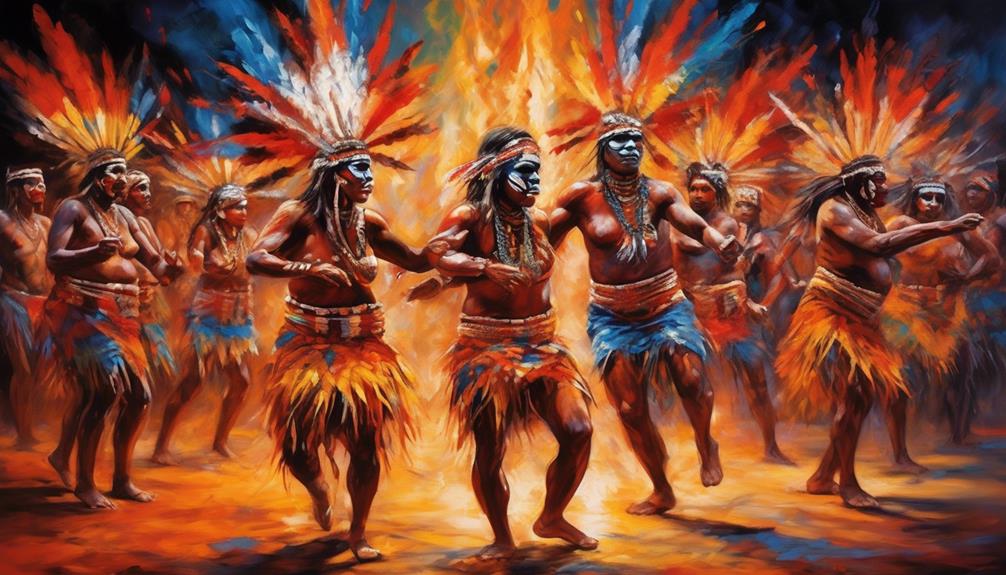
Indigenous cultural traditions encompass a rich tapestry of ceremonial practices, traditional beliefs, and artistic expressions that have been passed down through generations. These traditions play a vital role in shaping the identity and spirituality of Aboriginal communities, serving as a means of connecting with ancestors and the natural world.
From intricate dance rituals to vibrant visual arts, the diversity and depth of Indigenous cultural traditions reflect the resilience and creativity of Aboriginal people.
Ceremonial Practices
Ceremonial practices within Aboriginal cultures hold significant importance in preserving and celebrating traditional customs and beliefs. These rituals are deeply rooted in the cultural significance and spiritual connection to the land and ancestors.
Traditional rituals such as the smoking ceremony, a cleansing and healing practice, are performed to ward off bad spirits and bless the land.
Ceremonial practices, like corroborees, involve community engagement through song, dance, and storytelling, serving as a way to pass down oral traditions and maintain social cohesion.
Initiation ceremonies, marking the transition to adulthood, are vital in instilling cultural values and responsibilities in the younger generation, ensuring the continuity of Indigenous knowledge and practices.
These ceremonial practices are integral to the Aboriginal identity and play a crucial role in maintaining the rich cultural heritage of Indigenous communities.
Traditional Beliefs
Deeply intertwined with the fabric of Aboriginal societies, traditional beliefs encompass a rich tapestry of spiritual and cultural customs that have endured through generations. Ancestral connections form the cornerstone of these beliefs, shaping the Aboriginal worldview and guiding their spiritual practices.
The profound reverence for the land, known as Country, is central to their beliefs, reflecting a deep spiritual connection to the earth and its ecosystems. Dreamtime stories, passed down through oral traditions, hold the collective wisdom of the Aboriginal people, teaching essential lessons and preserving their cultural heritage.
Spiritual practices, such as song, dance, and art, are integral to their traditions, serving as a means of connecting with the spiritual realm and honoring their ancestors. These traditional beliefs aren't static but continue to evolve, demonstrating the resilience and adaptability of Aboriginal cultures in the face of change.
Artistic Expressions
Artistic expressions play a vital role in Aboriginal cultures, serving as a powerful means of conveying their rich traditions and spiritual connections.
- Dreamtime paintings: These intricate artworks depict Aboriginal creation stories and serve as a visual representation of their cultural beliefs and practices.
- Didgeridoo music: The haunting sound of the didgeridoo holds immense cultural significance, often used in ceremonies and storytelling to connect with ancestral spirits.
- Carved boomerangs: These skillfully crafted objects hold both practical and spiritual significance, used for hunting as well as in ceremonial rituals to honor the land and ancestors.
Artistic expressions are deeply rooted in Aboriginal cultural significance, serving as a way to preserve and pass down traditions, foster a sense of community, and connect with the spiritual world.
Aboriginal Connection to the Land
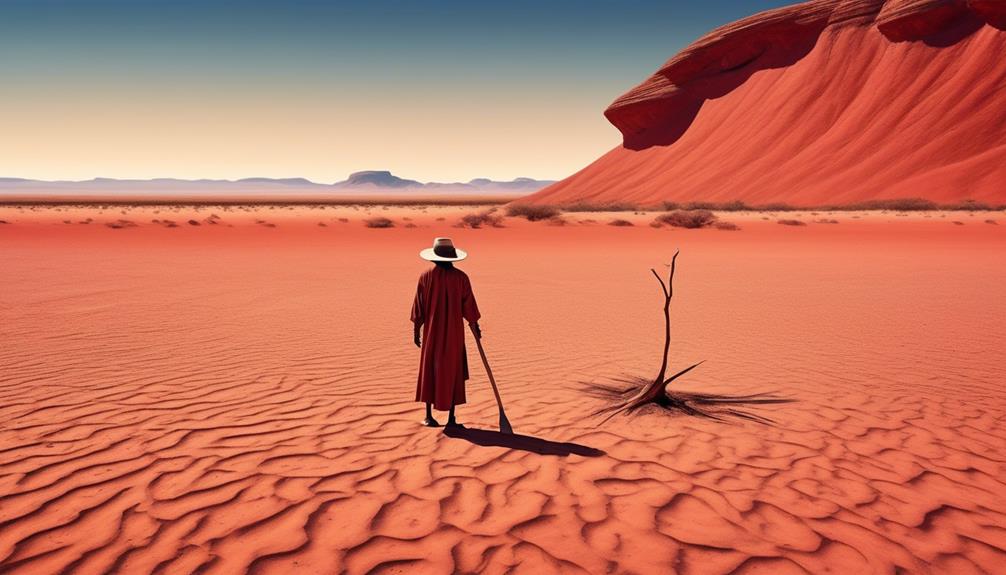
The Aboriginal people have a profound and enduring connection to the land, rooted in their cultural and spiritual beliefs. Land connection holds deep spiritual significance for Aboriginal communities. It isn't merely physical space but a fundamental part of their identity, culture, and existence. The land is intricately woven into their Dreamtime stories, which are the oral traditions that explain the creation of the world and the laws that govern their society. These stories are passed down through generations and are essential in shaping their understanding of the world and their place within it.
The spiritual significance of the land is reflected in the Aboriginal people's rituals, ceremonies, and art. The land is regarded as a source of life, spirituality, and knowledge. It provides sustenance, medicine, and shelter, and is the resting place of their ancestors. This deep spiritual connection to the land influences their traditional practices, environmental stewardship, and conservation efforts. The land isn't viewed as a commodity to be exploited but as a sacred inheritance to be respected and preserved for future generations.
Furthermore, the land serves as a repository of Aboriginal knowledge, containing valuable information about navigation, food sources, and seasonal changes. This knowledge is crucial for their survival and has been honed through thousands of years of living in harmony with the land. The connection to the land isn't just physical but encompasses a holistic relationship that encompasses spiritual, cultural, and ecological dimensions.
Traditional Aboriginal Society
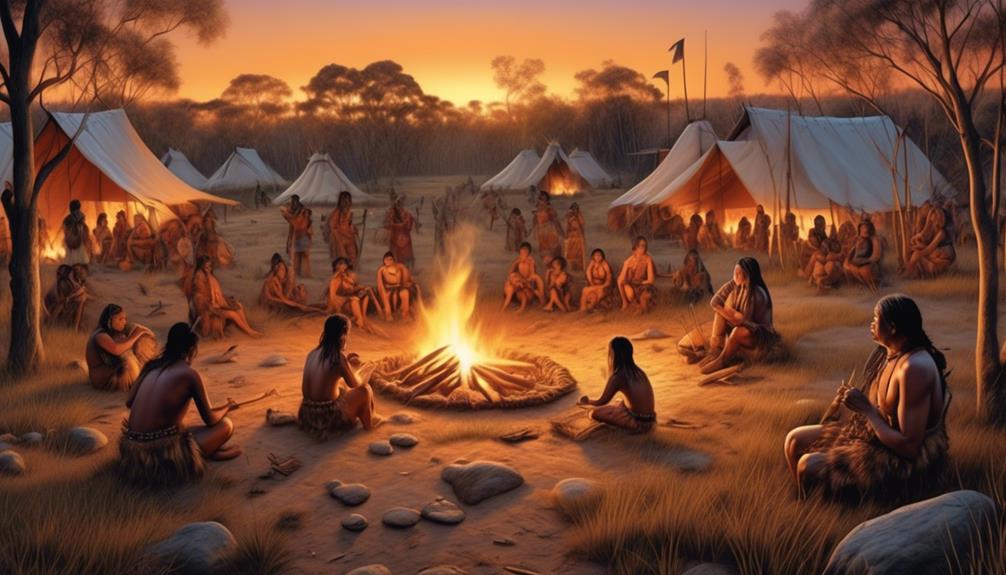
Traditional Aboriginal society is characterized by intricate kinship systems that dictate roles and responsibilities within the community.
The connection to the land is central to their spirituality, with the belief that the land is a living, breathing entity that must be respected and cared for.
Dreaming stories, passed down through generations, play a crucial role in preserving the cultural knowledge and spirituality of Aboriginal people.
Kinship and Roles
In Aboriginal society, kinship and roles play a central and defining role in the social structure and organization of the community.
Kinship dynamics are complex and are based on intricate systems of familial relationships, which form the foundation of Aboriginal social organization.
Cultural roles and responsibilities are deeply intertwined with kinship, with each individual being assigned specific duties, obligations, and privileges based on their position within the kinship system.
The kinship system also governs marriage rules, inheritance, and land ownership, shaping the way in which Aboriginal communities interact and function.
This intricate web of kinship and roles forms the framework through which Aboriginal societies operate, creating a cohesive and interconnected community that values the contributions of each member.
Land and Spirituality
Land and spirituality hold profound significance in the fabric of Aboriginal society. They are deeply intertwined with the intricate web of kinship and roles that shape their community.
The land isn't merely a physical space for the Aboriginal people; it's a living entity. It is imbued with spiritual significance and cultural connection. Sacred sites dot the landscape, each holding deep cultural significance and spiritual resonance.
These sites aren't simply geographical locations but repositories of ancestral stories, knowledge, and wisdom. The Aboriginal people's connection to the land transcends mere physical stewardship. It encompasses environmental stewardship driven by their spiritual beliefs.
This deep spiritual connection to the land fosters a profound sense of responsibility to care for and protect the natural environment. It's this interconnectedness of spirituality and land that forms the foundation of traditional Aboriginal society.
Dreaming Stories
How do Dreaming Stories shape the cultural identity and beliefs of the Aboriginal people?
Dreaming stories play a pivotal role in shaping the cultural identity and beliefs of the Aboriginal people. They aren't just tales; they're the embodiment of the Aboriginal cultural and spiritual identity, serving as a guide for their existence.
- Dreaming stories interpretation holds immense cultural significance, providing a framework for understanding the world, their origins, and their place within it.
- The transmission of Dreaming stories ensures the generational knowledge and wisdom are passed down, maintaining cultural continuity and identity.
- These stories are more than myths; they're a living connection to the land, ancestors, and spiritual beliefs, grounding the Aboriginal people in their cultural heritage.
Impact of Colonization
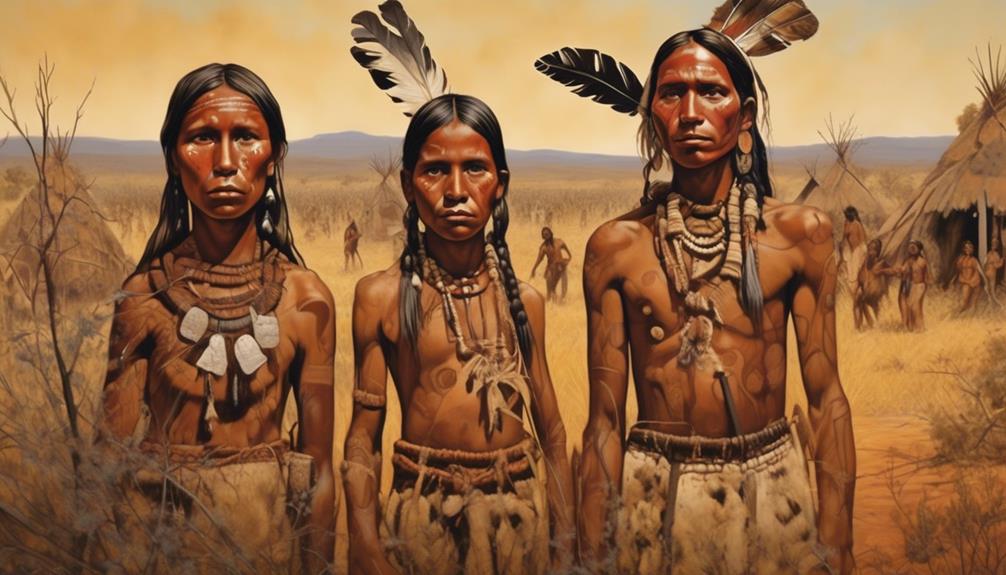
Upon the arrival of European settlers, the Aboriginal people experienced significant upheaval in their traditional way of life due to the impact of colonization. The colonization impact led to the loss of land, resources, and autonomy. The imposition of foreign laws and governance systems disrupted established societal structures, leading to the erosion of traditional cultural practices and knowledge transmission. This upheaval continues to reverberate in contemporary Aboriginal identity, shaping their social, economic, and political realities.
The colonization impact fractured the cohesive fabric of Aboriginal communities, leading to displacement, dispossession, and intergenerational trauma. The forced assimilation policies, such as the removal of children from their families, commonly referred to as the Stolen Generations, resulted in a profound loss of cultural connection and identity. The enduring ramifications of these historical injustices have led to complex socio-economic challenges, including higher rates of unemployment, poverty, and health disparities within Aboriginal communities.
Moreover, the colonization impact disrupted the spiritual connection to the land, which is fundamental to the Aboriginal cosmology and worldview. The desecration of sacred sites and environmental degradation further deepened the sense of cultural dislocation and loss. Despite these challenges, the Aboriginal people have demonstrated resilience and persistence in reclaiming and revitalizing their cultural heritage, asserting their rights, and advocating for self-determination.
Aboriginal Resistance and Survival
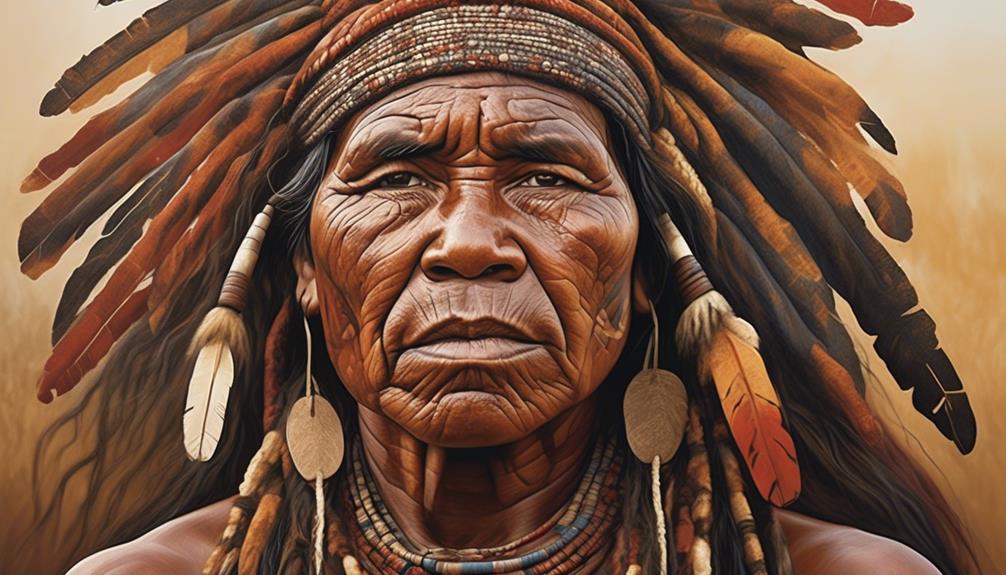
The enduring ramifications of colonization have fueled the Aboriginal people's resilience and persistence in the face of adversity, leading to a legacy of resistance and survival that continues to shape their cultural identity. Despite the devastating impact of colonization, the Aboriginal people have demonstrated remarkable strength and determination in preserving their cultural heritage and resisting the forces that sought to erase their existence.
- Cultural Resilience: The Aboriginal communities have actively sought to maintain and revitalize their languages, traditions, and spiritual practices, safeguarding their cultural identity from the eroding effects of colonialism.
- Resistance Movements: Throughout history, Aboriginal people have engaged in various forms of resistance against oppressive colonial policies, including protests, legal battles, and advocacy for land rights, asserting their sovereignty and right to self-determination.
- Survival Strategies: In the face of systemic discrimination and marginalization, Aboriginal communities have developed innovative survival strategies, such as community-led initiatives focused on education, health, and economic empowerment, strengthening their ability to thrive in the modern world while staying true to their heritage.
The Aboriginal people's resilience and survival in the face of colonial impact stand as a testament to their unwavering spirit and determination to overcome historical injustices. The legacy of resistance and survival continues to inspire future generations, shaping the ongoing struggle for liberation and the preservation of Aboriginal cultures.
Contemporary Aboriginal Identity
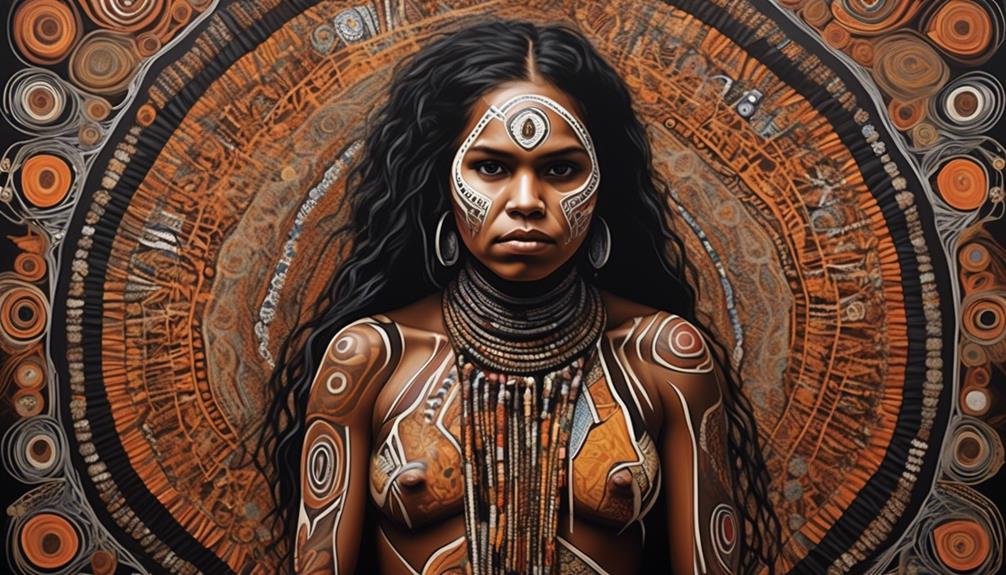
In contemporary times, Aboriginal identity is shaped by a complex interplay of cultural practices, language revival efforts, and ongoing land rights struggles.
Aboriginal cultural practices, such as art, storytelling, and traditional ceremonies, play a significant role in maintaining and perpetuating Aboriginal identity in the face of historical and ongoing challenges.
Additionally, the revival and preservation of Aboriginal languages are crucial in the reclaiming and preservation of cultural heritage, while the fight for land rights remains a pivotal aspect of asserting and maintaining Aboriginal identity in modern Australia.
Aboriginal Cultural Practices
Contemporary Aboriginal identity is shaped by a rich tapestry of cultural practices that have endured and evolved over centuries. Despite the impact of globalization on traditional practices, Aboriginal cultural preservation efforts remain strong.
Three prominent cultural practices include:
- Art and Storytelling: Aboriginal art, including dot paintings and rock art, continues to be a vital form of cultural expression, often conveying Dreamtime stories and important ancestral knowledge.
- Ceremonies and Rituals: Traditional ceremonies, such as corroborees and smoking ceremonies, still hold significant spiritual and social importance within Aboriginal communities.
- Connection to Country: The deep spiritual connection to the land, known as 'Country', remains a fundamental aspect of Aboriginal cultural identity, shaping their relationship with the environment and their sense of belonging.
Aboriginal Language Revival
Despite the impact of globalization on traditional practices, Aboriginal cultural preservation efforts remain strong, and a significant aspect of this contemporary identity is the revival of Aboriginal languages.
Aboriginal language preservation is a crucial component of maintaining cultural heritage and identity. Language revitalization initiatives play a pivotal role in reclaiming and celebrating Aboriginal languages, which have faced the threat of extinction due to historical assimilation policies. These initiatives include language immersion programs, community language classes, and the development of educational resources.
Aboriginal Land Rights
The assertion of Aboriginal land rights is a pivotal aspect of contemporary Aboriginal identity, encompassing the ongoing struggle for recognition, sovereignty, and connection to ancestral lands.
Aboriginal land rights entail the fight for the recognition of traditional ownership and control over ancestral lands, often in the face of historical dispossession and marginalization. Indigenous communities seek to assert their inherent right to land, acknowledging their deep spiritual and cultural connection to these territories.
The struggle for aboriginal land rights involves advocating for the restitution of lands, the protection of sacred sites, and the preservation of traditional ecological knowledge. It's a continuous battle for autonomy and self-determination, rooted in the fundamental belief that indigenous peoples have the right to govern their own lands and resources in accordance with their customs and traditions.
Aboriginal Art and Expression
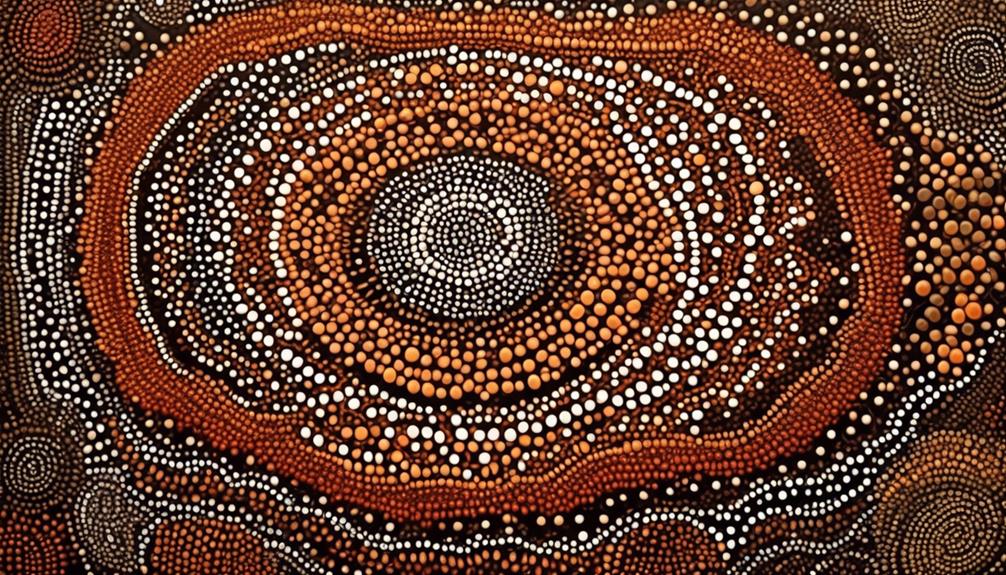
Aboriginal art and expression encompass a rich cultural heritage, reflecting the spiritual connection to the land and the storytelling traditions of the indigenous peoples of Australia. It's deeply rooted in Traditional beliefs and artistic expressions, serving as a means of passing down knowledge, traditions, and cultural practices from one generation to another. Aboriginal art is diverse, ranging from rock paintings, bark paintings, and ceremonial body paintings to sculptures, weaving, and contemporary art forms. Each art form holds its own significance, often depicting Dreamtime stories, which are the creation myths and spiritual beliefs of the Aboriginal people.
Cultural expression through art is integral to the Aboriginal way of life, serving as a vehicle for communication and connection to the land. The art isn't merely decorative but holds spiritual, ceremonial, and educational importance. It serves as a medium to convey the deep spiritual connection to the land, the significance of ancestral stories, and the importance of preserving cultural heritage. Through artistic expressions, Aboriginal people maintain a strong sense of identity, resilience, and resistance against the historical and ongoing impact of colonization.
Furthermore, the art is a form of resistance and liberation, as it challenges the dominant narratives and serves as a means of reclaiming cultural autonomy. It's a powerful tool for asserting Aboriginal presence, perspectives, and rights in contemporary society. The intricate patterns, vibrant colors, and symbolic representations in Aboriginal art convey a profound connection to the land and a rich cultural legacy, offering insight into the complex and diverse Aboriginal worldviews.
Aboriginal Languages and Communication
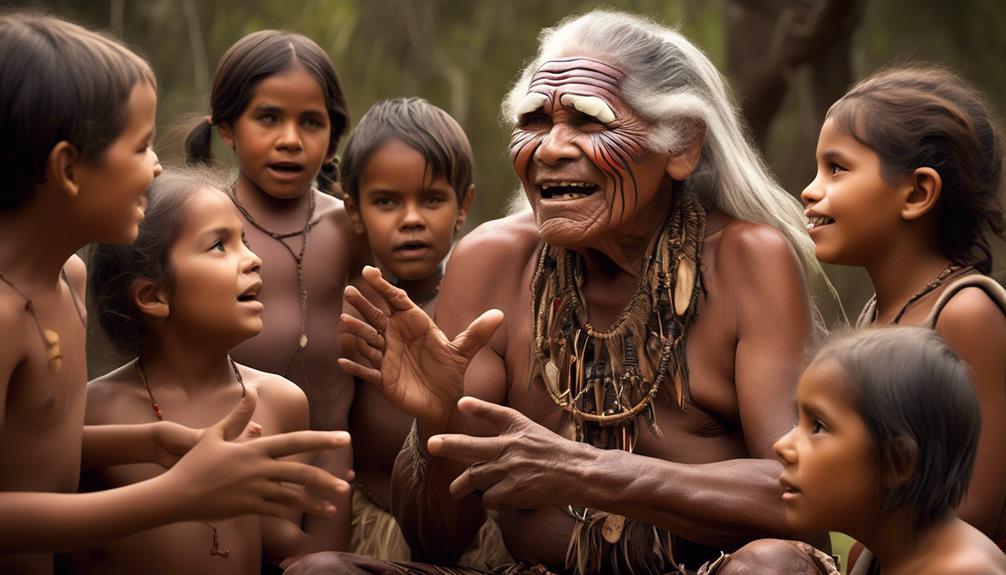
Aboriginal languages are known for their diversity, with hundreds of distinct languages and dialects spoken across different Indigenous communities.
These languages aren't only a means of communication but also carry the rich oral storytelling traditions of Aboriginal cultures.
Understanding the significance of these languages and communication methods is crucial in preserving the cultural heritage and traditions of Aboriginal peoples.
Language Diversity
Language diversity among Aboriginal communities in Australia reflects the rich linguistic heritage and communication practices of these diverse cultural groups. The preservation of Aboriginal languages is of historical significance and plays a crucial role in cultural diversity and community revitalization.
- Oral Tradition: Many Aboriginal languages are primarily spoken, passed down through generations via oral tradition, showcasing the intricate and expressive nature of verbal communication.
- Artistic Expression: Aboriginal languages are often intertwined with artistic practices, such as storytelling, song, and dance, serving as a vehicle for cultural preservation and transmission.
- Local Variations: The diversity of Aboriginal languages across different regions highlights the unique ways in which communities have adapted their communication to reflect their specific environments and experiences.
Oral Storytelling Traditions
With the foundation of rich linguistic heritage and communication practices laid out, it's now imperative to explore the oral storytelling traditions within Aboriginal communities as a vital aspect of cultural preservation and transmission.
Storytelling techniques among Aboriginal people are deeply rooted in their cultural significance, serving as a means of passing down knowledge, traditions, and beliefs from one generation to another. These oral traditions are characterized by their dynamic and interactive nature, often involving audience participation and the use of vivid language and imagery.
In modern times, these storytelling traditions are being preserved and adapted to suit contemporary mediums such as digital storytelling, ensuring the continuation of this essential cultural practice. The preservation and modern adaptation of these oral storytelling traditions play a crucial role in maintaining the cultural identity and heritage of Aboriginal communities.
Aboriginal Kinship and Community
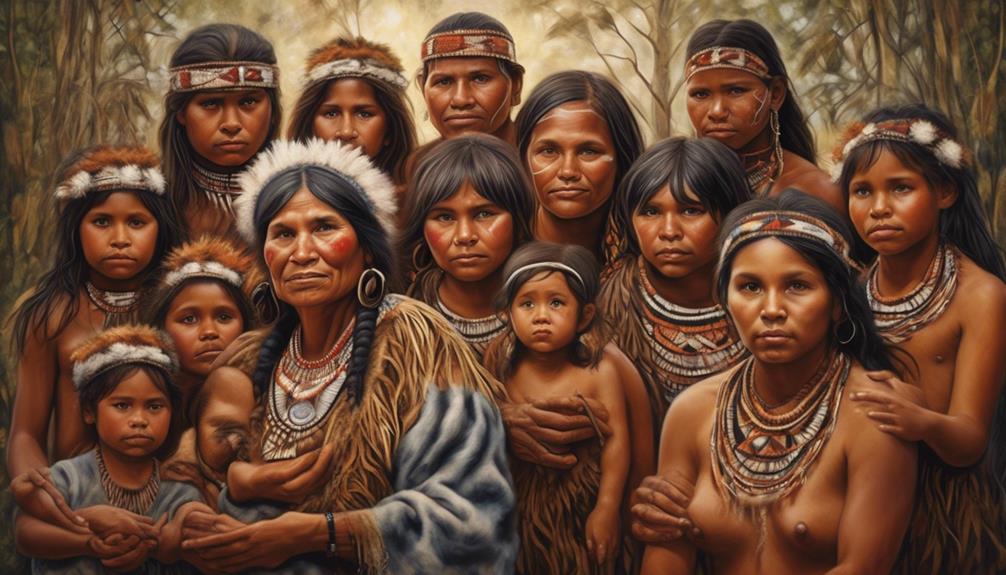
In traditional Aboriginal communities, kinship ties and social structure are integral to daily life and societal organization. The kinship dynamics among Aboriginal people play a fundamental role in shaping relationships, responsibilities, and obligations within the community. Community traditions are deeply rooted in the intricate web of kinship connections, which guide social interactions and decision-making processes.
- Intergenerational Bonds: The Aboriginal kinship system fosters strong intergenerational bonds, where elders hold a revered position within the community. They're esteemed for their wisdom, knowledge, and experience, and their guidance is highly valued in decision-making and conflict resolution.
- Collective Responsibility: Community traditions emphasize collective responsibility and mutual support. The kinship system extends beyond immediate family members, encompassing a broader network of relatives and community members. This interconnectedness fosters a sense of belonging and shared responsibility for the well-being of all members.
- Ceremonial Practices: Kinship dynamics influence ceremonial practices and rituals within Aboriginal communities. These ceremonies play a crucial role in reinforcing kinship ties, passing down cultural knowledge, and celebrating the interconnectedness of community members.
The intricate web of kinship relationships and community traditions forms the foundation of Aboriginal social structure, shaping the way individuals relate to one another and contribute to the collective welfare. These dynamics reflect a deep understanding of the interdependence of all members within the community, fostering a sense of unity and shared identity.
Aboriginal Spiritual Beliefs
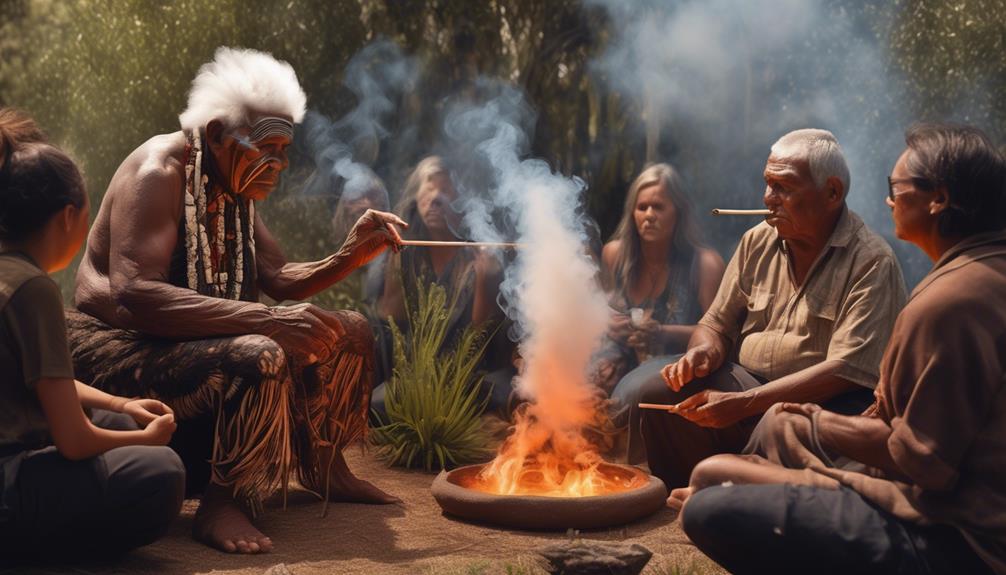
Rooted in a profound connection to the natural world, Aboriginal spiritual beliefs encompass a diverse array of traditions and practices that are deeply intertwined with cultural identity and ancestral heritage. Spiritual connections play a pivotal role in the lives of Aboriginal people, shaping their understanding of the universe and their place within it.
The Dreaming, also known as the Dreamtime, is a fundamental concept in Aboriginal spirituality, representing the time when ancestral spirits created the land, animals, and laws that govern the universe. This spiritual understanding isn't confined to a specific place or time but is a living, ongoing reality that informs Aboriginal cultural practices and beliefs.
Cultural significance is embedded in every aspect of Aboriginal spiritual beliefs, from the rituals performed to the stories shared through oral traditions. The land itself is considered sacred, and the relationship between the people and the land is central to Aboriginal spirituality. This profound connection to the land is reflected in the rituals and ceremonies that are conducted to honor and maintain spiritual connections with the natural world.
These rituals often involve dance, song, and art, serving as a means of preserving cultural heritage while also strengthening the spiritual bond with the land.
The interconnectedness of all living beings and the natural world is a core tenet of Aboriginal spiritual beliefs, emphasizing the importance of maintaining harmony and balance within the universe. This spiritual worldview shapes not only individual beliefs but also the collective practices and traditions that have been passed down through generations, reinforcing the enduring significance of Aboriginal spirituality in contemporary society.
Challenges Faced by Aboriginal Peoples
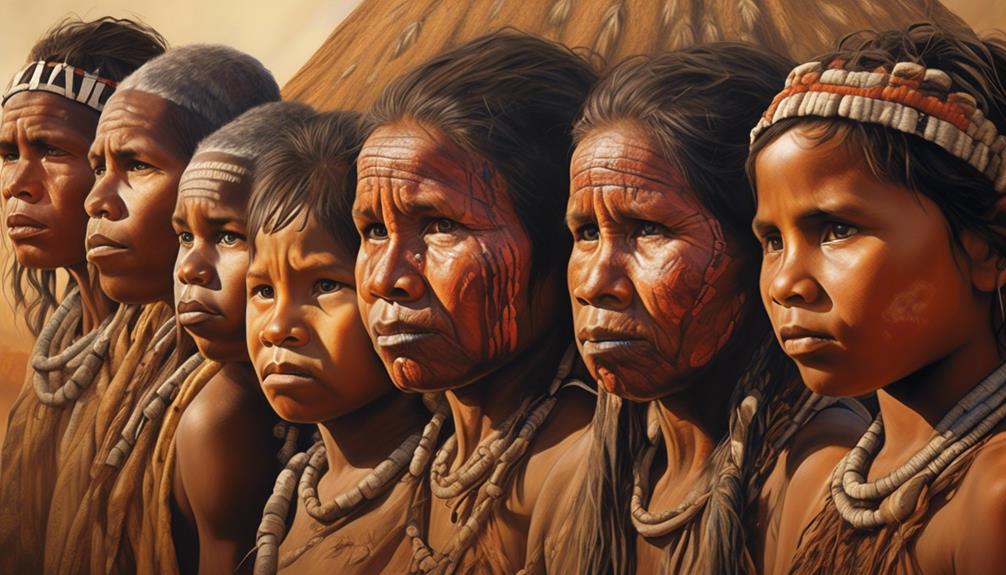
Embedded within the profound connection to the natural world and ancestral heritage, Aboriginal peoples face a myriad of challenges that impact their cultural identity and spiritual beliefs. These challenges manifest in various forms, posing significant obstacles to the preservation of their rich heritage and traditions.
- Social Inequalities: Aboriginal communities continue to grapple with systemic social inequalities, including limited access to quality healthcare, education, and employment opportunities. These disparities perpetuate cycles of poverty and marginalization, hindering the overall well-being and prosperity of Aboriginal peoples.
- Cultural Preservation: The ongoing struggle to protect and preserve traditional customs, languages, and knowledge is a central challenge for Aboriginal communities. The encroachment of modernity and globalization poses a threat to the continuity of cultural practices, leading to the potential loss of invaluable heritage that has been passed down through generations.
- Land Rights and Sovereignty: Aboriginal peoples face persistent challenges in asserting their land rights and sovereignty. Disputes over land ownership, resource extraction, and environmental degradation threaten the sacred connection that Aboriginal communities have with their ancestral lands, further exacerbating the erosion of their cultural identity and spiritual beliefs.
These challenges underscore the urgent need for concerted efforts to address social inequalities, safeguard cultural preservation, and uphold the rights of Aboriginal peoples. It's imperative to recognize and respect the unique cultural heritage of Aboriginal communities, working towards a future where their traditions and beliefs can thrive in harmony with the modern world.
Celebrating Aboriginal Achievements

Celebrating Aboriginal achievements highlights the resilience, creativity, and contributions of Aboriginal peoples to various fields and industries. Indigenous success stories are emerging in areas such as art, literature, sports, politics, and environmental activism. Aboriginal achievements in these domains not only showcase individual accomplishments but also contribute to cultural preservation and the revival of cultural heritage.
In the realm of art, Aboriginal artists are gaining international recognition for their unique styles and profound storytelling through various mediums such as painting, sculpture, and digital art. These artists aren't only preserving their cultural heritage but also using their work as a medium for social and political commentary.
Additionally, the literary world has been enriched by the powerful voices of Aboriginal authors, who are sharing their stories and experiences, contributing to a more diverse and inclusive literary landscape. Their works not only offer insights into Aboriginal culture and history but also provide a platform for addressing social issues and advocating for change.
In sports, Aboriginal athletes have excelled in various disciplines, breaking barriers and inspiring future generations. Their success not only showcases their individual talent and determination but also serves as a source of pride for Indigenous communities.
Moreover, Aboriginal leaders are making significant contributions to politics, advocating for Indigenous rights, environmental protection, and social justice. Their presence in the political arena amplifies the voices of Indigenous peoples and fosters greater representation.
Preserving Aboriginal Heritage
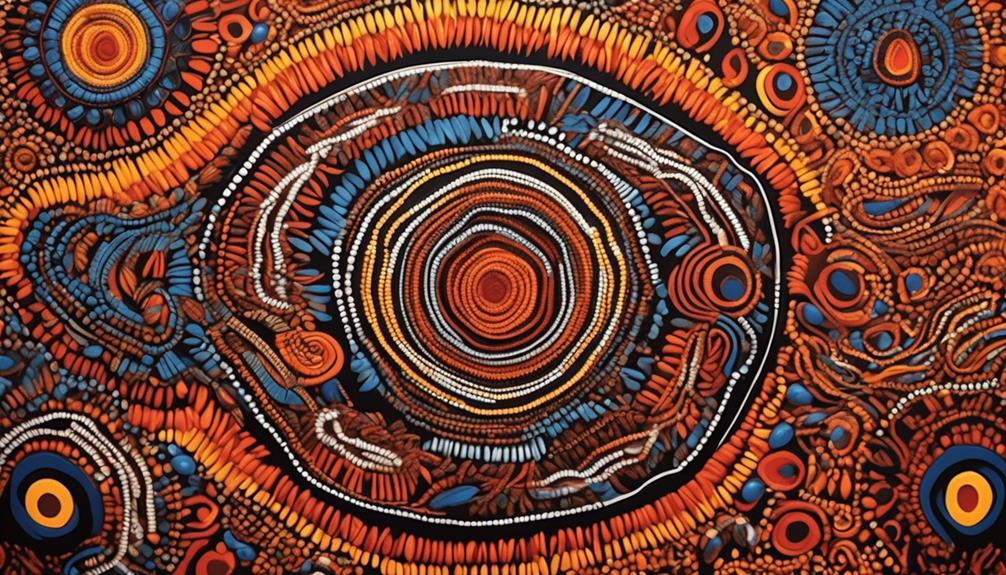
Preserving Aboriginal heritage entails safeguarding the cultural legacies and traditions that have contributed to the resilience and rich tapestry of Aboriginal peoples, encompassing art, literature, sports, politics, and environmental activism. The preservation methods employed to protect Aboriginal heritage are crucial in maintaining the cultural significance of these traditions.
These methods include:
- Oral Tradition: Preserving Aboriginal heritage often involves passing down knowledge, stories, and customs through oral tradition. This method ensures that the wisdom and experiences of previous generations aren't lost and continue to shape the identity of Aboriginal communities.
- Cultural Artifacts: The careful preservation of cultural artifacts, such as traditional clothing, tools, and artwork, is vital in upholding the tangible aspects of Aboriginal heritage. These artifacts serve as a powerful connection to the past and are essential in understanding the historical and cultural significance of Aboriginal traditions.
- Cultural Revitalization Programs: Many Aboriginal communities actively engage in cultural revitalization programs, which aim to revive and celebrate traditional practices, languages, and ceremonies. These programs play a significant role in ensuring that the richness of Aboriginal heritage remains vibrant and accessible for future generations.
Preservation methods like these are essential in maintaining the cultural significance of Aboriginal heritage, ensuring that the valuable traditions and customs continue to thrive and contribute to the diverse tapestry of human culture.
Supporting Aboriginal Rights
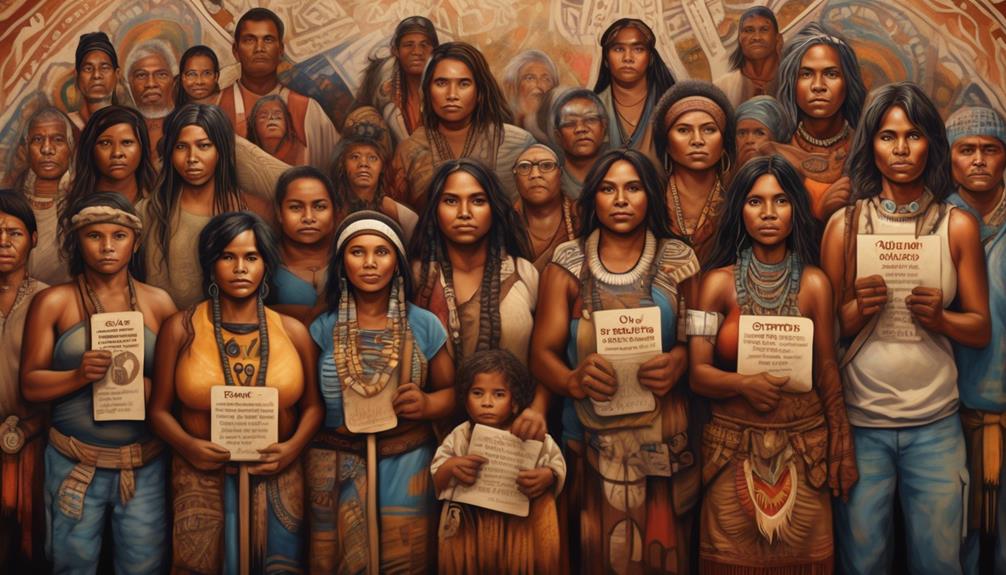
Supporting Aboriginal rights remains a critical endeavor in contemporary society, necessitating a comprehensive understanding of historical injustices and ongoing challenges faced by Aboriginal communities. It is a fundamental aspect of social justice and advocacy to ensure that Aboriginal peoples have equal rights, opportunities, and access to resources. Political activism and empowerment play a crucial role in addressing the systemic issues that continue to marginalize Aboriginal communities.
| Social Justice | Advocacy | Political Activism |
|---|---|---|
| Equality for all | Amplifying voices | Policy reform |
| Fair treatment | Legal support | Grassroots movements |
| Inclusivity | Community organizing | Lobbying efforts |
| Empowerment | Education | Civic engagement |
| Human rights | Awareness campaigns | Mobilization |
Advocacy for Aboriginal rights involves challenging discriminatory policies, promoting cultural awareness, and fostering inclusivity within institutions. It also encompasses providing legal support to address land rights, treaty disputes, and access to essential services. Political activism plays a pivotal role in influencing policy reform, initiating grassroots movements, and advocating for the rights of Aboriginal peoples at local, national, and international levels. Empowerment through education and civic engagement is vital in ensuring that Aboriginal voices are heard and their rights are respected.
Frequently Asked Questions
What Are the Main Challenges Faced by Aboriginal Peoples in Contemporary Society?
Facing significant challenges, Aboriginal peoples in contemporary society encounter discrimination, limited access to resources, and marginalization. Despite these obstacles, solutions are emerging through empowerment initiatives, advocacy, and community-driven efforts.
How Are Aboriginal Spiritual Beliefs and Practices Different From Those of Other Cultures?
Aboriginal spirituality encompasses unique cultural practices that differ from those of other cultures. Cross-cultural comparisons reveal distinct beliefs and rituals that shape their worldview.
Despite societal challenges, Aboriginal peoples have achieved recognition in arts, rights support, and heritage preservation. Their focus on the future generations is evident in their efforts to pass down their rich spiritual traditions. This commitment ensures the continuation of their unique cultural identity.
What Are Some Examples of Contemporary Aboriginal Achievements in Various Fields?
Contemporary achievements of Aboriginal people span diverse fields, showcasing their cultural contributions.
In art, the works of Emily Kame Kngwarreye and Clifford Possum Tjapaltjarri have gained international acclaim.
In sports, Cathy Freeman's Olympic triumphs exemplify excellence.
Additionally, Aboriginal scientists like Dr. Misty Jenkins make groundbreaking contributions.
Their achievements challenge stereotypes and inspire future generations.
These examples demonstrate the significant impact of Aboriginal people in various domains.
How Can Society Better Support and Uphold Aboriginal Rights?
We can support and uphold Aboriginal rights by prioritizing community engagement and political advocacy.
This involves actively involving Aboriginal communities in decision-making processes and amplifying their voices in political arenas.
By fostering genuine partnerships and advocating for policy changes, we can work towards a more just and equitable society for Aboriginal people.
This approach requires ongoing commitment and dedication to dismantling systemic barriers and addressing historical injustices.
What Efforts Are Being Made to Preserve and Protect Aboriginal Heritage for Future Generations?
Efforts to preserve and protect Aboriginal heritage for future generations involve initiatives such as cultural preservation programs, land conservation, and the safeguarding of traditional knowledge.
These efforts aim to ensure the continuation of Aboriginal cultural practices and the protection of sacred lands.
Conclusion
In conclusion, the Aboriginal people have a rich and diverse cultural heritage that spans thousands of years. Despite facing challenges and injustices, they continue to preserve their traditions and strive for recognition and rights.
How can we ensure that the voices and experiences of Aboriginal peoples are heard and respected in our society today? It's important to support and celebrate their achievements, while also acknowledging and addressing the ongoing struggles they face.
Nayeli is our dedicated Editor in Chief, bringing her passion for words and keen editorial eye to every piece of content we produce. With years of experience in the field, she ensures that every article and publication meets the highest standards of quality and clarity. Nayeli’s commitment to storytelling and her deep understanding of our mission make her an invaluable leader in our team.
